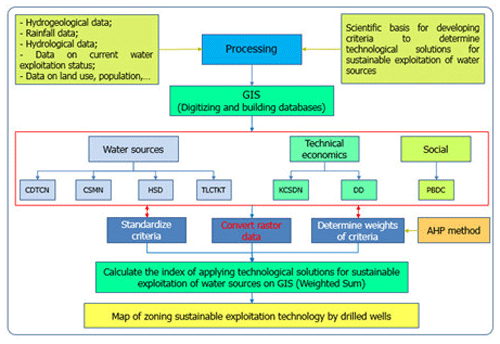Anh, D. N., et al.: Report on Research and propose models and technological solutions to exploit and protect sustainable development of karst water sources to serve domestic water supply in high mountainous, water-scarce areas in the Northern region, State-level of science and technology project of Vietnam, code: ĐTĐL.CN-61/15, https://www.most.gov.vn/cchc/tin-tuc/525/15991/thong-tin-ve-ket-qua-tu-danh-gia-de-tai-nghien-cuu-de-xuat-cac-mo-hinh–giai-phap-cong-nghe-khai-thac-va-bao-ve-phat-tr...un.aspx (last access: 20 March 2024), 265 pp., 2018 (in Vietnamese)
Fanao, M., Xiujuan, L., Changlai, X., and Wang, G.: Integration of GIS, improved entropy and improved catastrophe methods for evaluating suitable locations for well drilling in arid and semi-arid plains, Ecol. Indic., 131, 108124, https://doi.org/10.1016/j.ecolind.2021.108124, 2021.
Ghayoumian, J., Mohseni Saravi, M., Feiznia, S., Nouri, B., and Malekian, A.: Application of GIS techniques to determine areas most suitable for artificial groundwater recharge in a coastal aquifer in southern Iran, J. Asian Earth Sci., 30, 364–374, https://doi.org/10.1016/j.jseaes.2006.11.002, 2007.
Hou, E., Wang, J., and Chen, W.: A comparative study on groundwater spring potential analysis based on statistical index, index of entropy and certainty factors models, Geocarto Int., 33, 754–769, https://doi.org/10.1080/10106049.2017.1299801, 2017.
Indrani, M. and Umesh, K. S.: Delineation of groundwater potential zones in a drought-prone semi-arid region of east India using GIS and analytical hierarchical process techniques, CATENA, 194, 104681, https://doi.org/10.1016/j.catena.2020.104681, 2020.
Quyen, P. B., Minh, V. C., Nhan, D. D., Dung, D. V., Phuc, H. D., Hai, T. Q., Thu, L. N., Thuan, L. D., Huong, B. Q., and Yen, D. T. H.: Research on solutions to exploit and sustainably use water resources in the Karst high mountain areas of Northeast Vietnam. Applied experimentally in the Dong Van karst plateau, Science and technology project at Ministry of Natural resources and environment level, 221 pp., https://vista.gov.vn/news/khoa-hoc-ky-thuat-va-cong-nghe/nghien-cuu-giai-phap-khai-thac-su-dung-ben-vung-nguon-nuoc-tai-cac-vung-nui-cao-karst-dong-bac-viet-nam-1936.html (last access: 22 March 2024), 2017 (in Vietnamese).
Saaty, T. L.: The analytic hierarchy process (AHP), J. Oper. Res. Soc., 41.11, 1073–1076, 1980.
Statistical Yearbooks of Bac Kan, Bac Giang, Cao Bang, Dien Bien, Ha Giang, Hoa Binh, Lai Chau, Lang Son, Lao Cai, Phu Tho, Quang Ninh, Son La, Thai Nguyen, Tuyen Quang, Yen Bai provinces, Statistics Office, https://www.gso.gov.vn/du-lieu-va-so-lieu-thong-ke/2021/07/nien-giam-thong-ke-2021/ (last access: 22 March 2024), 2020 (in Vietnamese).
Suman, P., Pula, M., and Subhash, C. M.: Delineation of groundwater potential zone for sustainable development: A case study from Ganga Alluvial Plain covering Hooghly district of India using remote sensing, geographic information system and analytic hierarchy process, J. Clean. Prod., 172, 2485–2502, https://doi.org/10.1016/j.jclepro.2017.11.161, 2018.
Tam, V. T., Nhan, P. Q., Tu, N. T., Toan, D. N., Ha, N. T., Cong P. V., Toan, B. V., Thuc, P. Q., Giang, N. V., and Tuyen, L. V.: Report on Revising – Establishing a map of ground water resources at a scale of 1:200000 for provinces nationwide, Ministry-level of Natural resources and environment project, Hanoi, Vietnam, 132 pp., 2018 (in Vietnamese).








